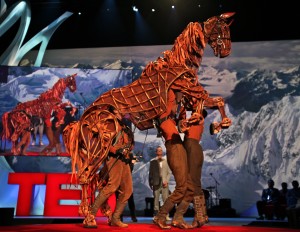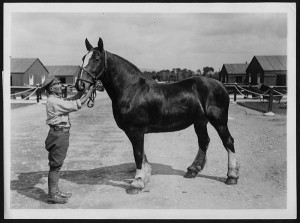Unless you’ve been living under a rock for the last few years, you’re bound to have heard something about War Horse. It started life as a children’s book by Michael Morpurgo, about the wartime experiences of a horse named Joey who was part of the British cavalry in World War One.
In recent years, it has been made into a phenomenally successful stage show, with actors operating beautiful puppets to represent the horses - having been instructed on how horses move and behave by a Battery Sergeant Major from the Royal Artillery. It’s even made it onto the silver screen, courtesy of a Hollywood film directed by Stephen Spielberg.

The story is fiction, of course, but there were large numbers of horses involved in World War One in all sorts of capacities, including for cavalry, pulling supplies, artillery and hospital wagons. In 1917, there were nearly 870,000 horses and mules working for the Army, often in much the same awful conditions as the men at the front. This meant that veterinary facilities were vital.

Digging War Horse
If you’ve read previous blogs, you’ll be familiar with Operation Nightingale, a joint venture between DIO and The Rifles to allow wounded or traumatised veterans and service personnel to take part in archaeological digs on the military estate, which can play a part in helping their recovery. One recent project, named ‘Digging War Horse’ was to examine the suspected site of the horse hospital from the First World War.
![A metal badge from an Australian soldier. [Richard Osgood; Crown Copyright]](https://insideDIO.blog.gov.uk/wp-content/uploads/sites/29/2014/10/2014-Sept-ANZAC-metal-logo-Richard-Osgood-Crown-Copyright-300x199.jpg)
We knew there had been a hospital for soldiers there and there are references on heritage lists to an equine equivalent. To decide where to dig, we conducted a walking field survey - the land belongs to the MOD but is farmed by a tenant farmer – looked at maps and conducted a geophysical survey as well as using metal detectors. We then dug test pits to see what turned up and if we were looking in the right place.
We didn’t find anything directly linking to a horse hospital but we did make plenty of other discoveries, including First World War ammunition; buttons and badges from British and Anzac soldiers; part of the periscope from an armoured vehicle; and remains of the buildings which used to stand there. There were also lots of horse shoes.
![A number of labelled horseshoes found on the dig. [Richard Osgood; Crown Copyright]](https://insideDIO.blog.gov.uk/wp-content/uploads/sites/29/2014/10/2014-Sept-Horseshoe-finds-Richard-Osgood-Crown-Copyright-300x199.jpg)
Presenting the Project
In January we intend to display the results of the dig to the public. We’ll explain what we did and what we found, alongside other exhibitors – the Royal Artillery will be displaying some of their World War One memorabilia and field guns and visitors will even be able to try trench food. Michael Morpurgo is also going to attend and give a presentation, and we hope that the puppets from the play will also be there for visitors to see.
All in all, it should be a fantastic event. If you’re in the area, keep an eye out for details nearer the time – it would be great to see you there!
![The British Army still uses horses, but only for ceremonial reasons. Here, soldiers of the Kings Troop Royal Horse Artillery form up on Horse Guards parade ground as they take over Queen's Life Guard duties from HM The Life Guards in 2010. [Sgt Dan Harmer, Crown Copyright]](https://insideDIO.blog.gov.uk/wp-content/uploads/sites/29/2014/10/Kings-Troop-Royal-Horse-Artillery-Sgt-Dan-Harmer-Crown-Copyright-300x197.jpg)
Read more about 'Digging War Horse' on the project blog and on the blog of Harvey Mills, a professional photographer who took part in and photographed the dig.
1 comment
Comment by julian edwards posted on
i have found well over 100 ww1 horse shoes at theb site of the blacksmith at the army training camp at claremont tasmania 1st light horse .they are exposed to the elements after the may storms .have saved a number of shoes and some old tools ,bottle ect
i am hoping to get a dig started to preserve these important lik to our anac past